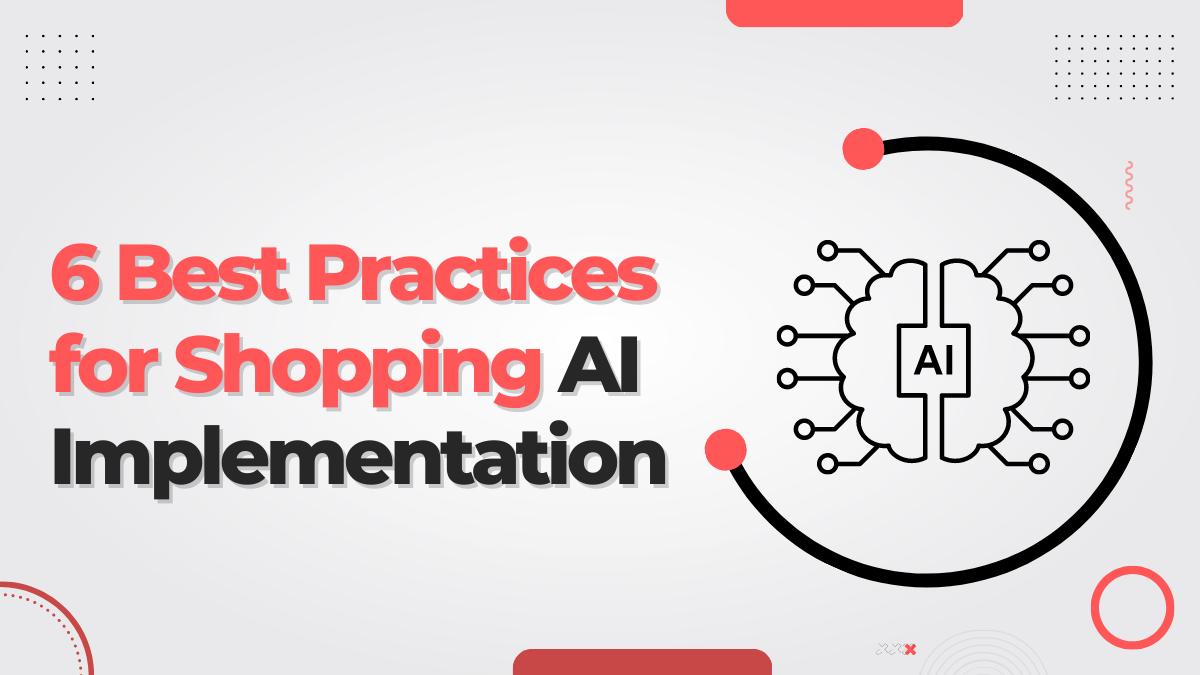6 Best Practices for Shopping AI Implementation

The technology industry is rapidly evolving and Artificial Intelligence (AI) is at the forefront of this evolution. As businesses continue to explore new ways of leveraging AI for their shopping needs, it’s important to follow best practices that ensure a successful implementation. Furthermore, the most common mistakes and pitfalls to avoid should be addressed to ensure the success of any shopping AI project.
The practical application of shopping AI Decoder can manifest in many forms, from personalized product recommendations to predicting customer trends or optimizing pricing and inventory. Enterprises can employ AI-driven solutions to improve customer experience and increase sales while optimizing efficiency and cost.
To get the most out of shopping AI implementation, here are eight best practices to follow:
1. Identifying Opportunities to Implement AI-Based Shopping Solutions
To take advantage of the full potential of AI-driven solutions, businesses must first identify opportunities to leverage AI within their existing operations. This could include real-time pricing optimization based on market demand or personalized product recommendations based on customer data.
- Analyzing current customer shopping habits and preferences. AI-driven systems can analyze customer shopping data and enable companies to understand customer behavior better. This helps businesses offer their customers the right products, promotions, and discounts.
- Identifying areas of potential efficiency improvement. By leveraging AI, businesses can identify areas in the shopping process that could be improved to drive efficiency and cost savings. This could include automating certain processes or identifying ways to reduce customer service costs.
- Exploring AI technology solutions that align with business goals. Businesses should assess which AI-driven solutions make the most sense for their particular goals and objectives.
2. Creating a Strategy for Rolling Out Ai-Based Shopping Solutions
Once the opportunities for AI-based shopping solutions have been identified, businesses should create a strategy for rolling out these solutions. This includes considering the costs associated with implementation, as well as the benefits that will be realized from the use of AI-driven systems.
- Defining the scope of the AI-based shopping project. Businesses should limit the scope of their AI-based shopping project and determine which areas will be targeted for improvement. This includes identifying the objectives that need to be met and the timeline for achieving these goals.
- Developing a budget. Companies should establish a budget for their AI-based shopping project, taking into account all costs associated with implementation, including technology and labor costs.
- Identifying resources needed and costs associated with implementation. Businesses should identify any necessary resources to successfully implement their AI-based shopping solution, such as personnel, hardware, software, and other necessary technology.
3. Developing an Effective User Interface for Shopping AI
For an AI-based shopping system to be effective, it must have an intuitive and easy-to-use user interface. Designing a user-friendly platform will ensure that customers can interact with the AI quickly and easily.
- Prioritizing customer needs. Companies should prioritize customer needs when designing their user interface, making sure that the platform is designed to meet specific customer needs.
- Ensuring the interface is easy to navigate and intuitive. Companies should ensure that their AI-driven shopping interface is easy to navigate, so customers can quickly find what they are looking for. Moreover, the interface should be designed to provide helpful recommendations and product information.
- Utilizing customer feedback to refine the user experience. This could include conducting surveys or executing focus groups to get direct customer input on how the platform can be improved. This way, companies can ensure they are providing the best possible customer experience.

4. Choosing the Right AI Platform for Shopping Solutions
Once companies have identified the right AI-based solutions for their needs, they should select an appropriate AI platform that meets their budget and technical requirements. Some factors to consider when selecting a platform include the following:
- Cost of implementation. Companies should carefully evaluate the cost of implementing each platform to ensure it fits within their budget.
- Security of data. Companies should also assess the security and privacy features offered by each platform to ensure customer data is protected from malicious actors.
- Level of customization. Businesses should consider how much they can customize the platform to fit their unique needs and objectives.
- Evaluating Features. Companies should evaluate the features offered by each platform to ensure they are meeting their desired outcomes. This could include assessing AI-driven features such as machine learning, natural language processing, and more.
5. Utilizing Data to Enhance Shopping AI Performance
Data is an essential component of AI-based shopping solutions, enabling businesses to enhance their system performance. Companies should ensure they are leveraging data effectively and taking steps to protect sensitive customer information.
- Collecting relevant data. Companies should look for ways to collect more accurate and up-to-date data, such as customer demographics and purchase histories.
- Analyzing data to inform decisions. Companies should analyze the collected data to understand their customer’s behavior and preferences so that they can make more informed decisions about product selection, pricing, marketing strategies, etc.
- Protecting customer data. Businesses should ensure they protect customer data by following best practices such as encryption and regular security audits.
6. Adapting Shopping AI Solutions for Long-Term Success
Once companies have implemented their AI-driven shopping solutions, they should look for ways to continuously improve the system to ensure it remains competitive and relevant. This could include:
- Implementing periodic updates. Companies should regularly update the platform with the latest technology and features to meet customer needs.
- Testing new features. Companies should consider testing new features to enhance their AI-driven shopping solutions and improve customer experience.
- Measuring results. Companies should track performance metrics such as conversion rate, clickthrough rate, and more to understand how the platform is performing and make adjustments accordingly.
In Conclusion
AI-based shopping solutions can offer businesses a variety of advantages, from better customer engagement to improved efficiency. However, companies must take the time to identify their AI needs, develop an effective user interface, select the right platform for their budget and technical requirements, and continuously refine the system for long-term success. By doing so, businesses can stay ahead of the competition and optimize their AI-driven shopping solutions for maximum returns.




